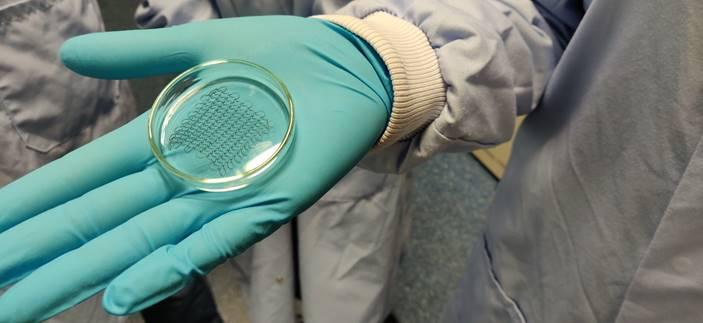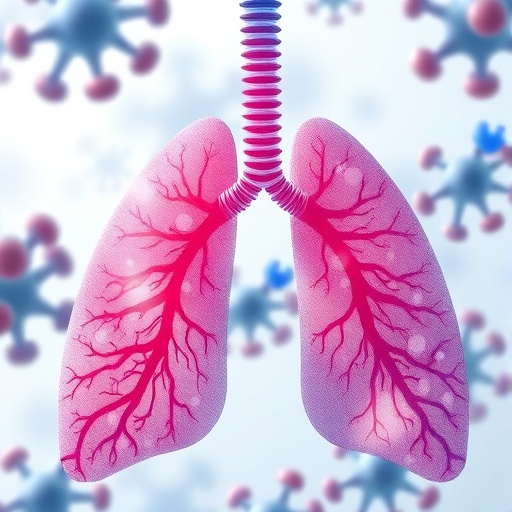
Credit: Dr Gillian Hendy
Bioengineers from Trinity College Dublin, Ireland, have developed a prototype patch that does the same job as crucial aspects of heart tissue.
Their patch withstands the mechanical demands and mimics the electrical signalling properties that allow our hearts to pump blood rhythmically round our bodies.
Their work essentially takes us one step closer to a functional design that could mend a broken heart.
One in six men and one in seven women in the EU will suffer a heart attack at some point in their lives. Worldwide, heart disease kills more women and men – regardless of race, than any other disease.
Cardiac patches lined with heart cells can be applied surgically to restore heart tissue in patients who have had damaged tissue removed after a heart attack and to repair congenital heart defects in infants and children. Ultimately, though, the goal is to create cell-free patches that can restore the synchronous beating of the heart cells, without impairing the heart muscle movement.
The bioengineers report their work, which takes us one step closer to such a reality, in the journal Advanced Functional Materials.
Michael Monaghan, ussher assistant professor in biomedical engineering at Trinity, and senior author on the paper, said:
“Despite some advances in the field, heart disease still places a huge burden on our healthcare systems and the life quality of patients worldwide. It affects all of us either directly or indirectly through family and friends. As a result, researchers are continuously looking to develop new treatments which can include stem cell treatments, biomaterial gel injections and assistive devices.”
“Ours is one of few studies that looks at a traditional material, and through effective design allows us to mimic the direction-dependent mechanical movement of the heart, which can be sustained repeatably. This was achieved through a novel method called ‘melt electrowriting’ and through close collaboration with the suppliers located nationally we were able to customise the process to fit our design needs.”
This work was performed in the Trinity Centre for Biomedical Engineering, based in the Trinity Biomedical Sciences Institute in collaboration with Spraybase®, a subsidiary of Avectas Ltd. It was funded by Enterprise Ireland through the Innovation Partnership Program (IPP).
Dr Gillian Hendy, director of Spraybase® is a co-author on the paper. Dr Hendy commended the team at Trinity on the work completed and advancements made on the Spraybase® Melt Electrowriting (MEW) System. The success achieved by the team highlights the potential applications of this novel technology in the cardiac field and succinctly captures the benefits of industry and academic collaboration, through platforms such as the IPP.
Engineering replacement materials for heart tissue is challenging since it is an organ that is constantly moving and contracting. The mechanical demands of heart muscle (myocardium) cannot be met using polyester-based thermoplastic polymers, which are predominantly the approved options for biomedical applications.
However, the functionality of thermoplastic polymers could be leveraged by its structural geometry. The bioengineers then set about making a patch that could control the expansion of a material in multiple directions and tune this using an engineering design approach.
The patches were manufactured via melt electrowriting – a core technology of Spraybase® – which is reproducible, accurate, and scalable. The patches were also coated with the electroconductive polymer polypyrrole to provide electrical conductivity while maintaining cell compatibility.
The patch withstood repeated stretching, which is a dominant concern for cardiac biomaterials, and showed good elasticity, to accurately mimic that key property of heart muscle.
Professor Monaghan added:
“Essentially, our material addresses a lot of requirements. The bulk material is currently approved for medical device use, the design accommodates the movement of the pumping heart, and has been functionalised to accommodate signaling between isolated contractile tissues.”
“This study currently reports the development of our method and design, but we are now looking forward to furthering the next generation of designs and materials with the eventual aim of applying this patch as a therapy for a heart attack.”
Dr Dinorath Olvera, Trinity, first author on the paper, added:
“Our electroconductive patches support electrical conduction between biological tissue in an ex vivo model. These results therefore represent a significant step towards generating a bioengineered patch capable of recapitulating aspects of heart tissue – namely its mechanical movement and electrical signalling.”
###
Media Contact
Michael Monaghan
[email protected]
353-189-68582
Original Source
https:/
Related Journal Article
http://dx.




